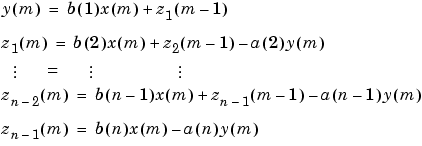

| MATLAB Function Reference |   |
Filter data with an infinite impulse response (IIR) or finite impulse response (FIR) filter
Syntax
y = filter(b,a,X) [y,zf] = filter(b,a,X) [y,zf] = filter(b,a,X,zi) y = filter(b,a,X,zi,dim) [...] = filter(b,a,X,[],dim)
Description
The filter function filters a data sequence using a digital filter which works for both real and complex inputs. The filter is a direct form II transposed implementation of the standard difference equation (see "Algorithm").
y = filter(b,a,X)
filters the data in vector X with the filter described by numerator coefficient vector b and denominator coefficient vector a. If a(1) is not equal to 1, filter normalizes the filter coefficients by a(1). If a(1) equals 0, filter returns an error.
If X is a matrix, filter operates on the columns of X. If X is a multidimensional array, filter operates on the first nonsingleton dimension.
[y,zf] = filter(b,a,X)
returns the final conditions, zf, of the filter delays. If X is a row or column vector, output zf is a column vector of max(length(a),length(b))-1. If X is a matrix, zf is an array of such vectors, one for each column of X, and similarly for multidimensional arrays.
[y,zf] = filter(b,a,X,zi)
accepts initial conditions, zi, and returns the final conditions, zf, of the filter delays. Input zi is a vector of length max(length(a),length(b))-1, or an array with the leading dimension of size max(length(a),length(b))-1 and with remaining dimensions matching those of X.
y = filter(b,a,X,zi,dim) and [...] = filter(b,a,X,[],dim)
operate across the dimension dim.
Example
You can use filter to find a running average without using a for loop. This example finds the running average of a 16-element vector, using a window size of 5.
data = [1:0.2:4]'; windowSize = 5; filter(ones(1,windowSize)/windowSize,1,data) ans = 0.2000 0.4400 0.7200 1.0400 1.4000 1.6000 1.8000 2.0000 2.2000 2.4000 2.6000 2.8000 3.0000 3.2000 3.4000 3.6000
Algorithm
The filter function is implemented as a direct form II transposed structure,
where n-1 is the filter order, and which handles both FIR and IIR filters [1].
The operation of filter at sample  is given by the time domain difference equations
is given by the time domain difference equations

The input-output description of this filtering operation in the  -transform domain is a rational transfer function,
-transform domain is a rational transfer function,

See Also
filtfilt, filtic in the Signal Processing Toolbox
References
[1] Oppenheim, A. V. and R.W. Schafer. Discrete-Time Signal Processing, Englewood Cliffs, NJ: Prentice-Hall, 1989, pp. 311-312.
 | fill3 | filter2 |  |